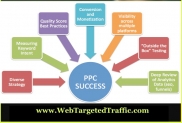
Top 10 PPC Marketing Mistakes (and How to Fix Them)
To craft a PPC ad that’s so compelling people are happy to click it. It doesn’t happen often.
If PPC has been around since 1996, why doesn’t it happen more often? Why haven’t advertisers perfected the process? Because the landscape is constantly changing. What you learned 6 months ago could already be outdated information.
Making wrong decisions while setting up a Pay-per-click (PPC) marketing campaign can cost you. Your ads, and even your whole account, can suffer as the result of common mistakes that are easily avoided.
That’s why we’ve put together this article, which covers the 10 most common mistakes that PPC marketers make.
Our goal in writing this guide is to increase your awareness of these problems, address the consequences, and discuss ways that you can to avoid the issues.
Table of Contents
Mistake #1: Not Knowing the Basics
Before you get started with any new software or program, it’s important that you know the fundamental concepts and formulas and have a solid grasp of how the program works.
Unfortunately, some PPC campaign managers overlook this fact and just jump right in, assuming that they can quickly figure out how everything works through simple trial and error.
Understanding the ideas behind ad ranking, bid adjustments, keyword types, etc. helps you understand how to make appropriate adjustments in your campaigns so that they are successful.
Without this basic knowledge, you can’t become more advanced.
“If you don’t know 2+2, you’ll never get to 4. — Tom Bukevicius, Principal, SCUBE Marketing
Mistake #2: Making Assumptions Instead of Using the Data
When you are setting up your PPC campaign, you may be tempted to use an automated software program or have Google automate things for you. That is not always a bad idea because automation can quickly take a campaign out of control. If you do not monitor and make decisions about each step of the campaign yourself, you may find yourself with a campaign that does not perform the way you intended.
It is always best to make decisions based on data when determining how to run a campaign or ad. That way, you will have a concrete understanding of how different things are working for you or your client, instead just guessing what might or could work.
Remember, every ad campaign is different. When starting a new ad, it is not necessarily a good idea to base it on what has worked in the past. What worked for one campaign doesn’t always hold true for another. And you know what they say happens when you assume. . .
Mistake #3: Spending Too Little or Spending in the Wrong Places
Everyone knows that spending too much on any particular marketing campaign is risky; but spending too little or spending in the wrong places can be just as ineffective. It’s important that you monitor your budget pacing for your campaigns and accounts. Doing so will keep you informed about how much money you have spent so that you know whether you are ahead or behind on your monthly budget.
At SCUBE, we create internal weekly budget and performance reports for each of our clients so we can make sure we are on the right track. This helps us see in which areas we need to pull back and in which we need to push a little more. It also helps us determine whether we are spending in the wrong places, such as in ad type or in targeting the wrong locations.
If you are too narrow in your geo-targeting, your ads will not perform as well as they could, and you will not get as many impressions as you need. Testing and trying different locations and services can open your eyes to a market you hadn’t originally thought about targeting.
Mistake #4: Being Too General in Your Ad Copy
Having broad and general ad copy may seem like a good way to draw in more customers and leads; but it’s also a good way to get your ads neglected by viewers in the search.
Make sure you target your audience to reach those who can benefit from your product or service. Use keywords that make the most sense for the campaign, ad group, ad, landing page, and company to give searchers a more clear and concise look at what you can offer them.
Also, be sure to use facts in the ad copy, not bold claims that you cannot back up like “Best Fuel Injector” or “Most Delicious Pizza.”
It is also possible to be too general with your site links. These are the links you can include at the bottom of your ad. If you are trying to send potential clients or customers to a certain landing page, don’t include links to your about-page or contact-page in the site links. Stick to the original funnel you designed so viewers stay on task and you get the sale or lead.
Mistake #5: Testing Too Much at Once
Testing too much at once is never a good idea because you will not be able to make clear and concise decisions based on your data and you’ll be spreading yourself too thin. With too much testing comes too many different outcomes, and you end up with results that don’t answer your questions.
Rather than test many different factors of your ad campaign together, test just one or two aspects at a time; that way you will have clear results and will be able to determine which features are working and which are not, or which performed better than the other.
Mistake #6: Using Keywords Inefficiently
It is important to use keywords correctly and in the appropriate circumstances. You should always make sure that your keywords are not used in multiple ad groups. Having clarity about which ad groups contain which lists of keywords will make maintenance more efficient later on.
You should also be sure that you’re using the right types of keywords. Too many broad-match keywords may bring in far too many searches that do not relate to your ad. Phrase match keywords, on the other hand, are not too broad and not too exact and are a good place to start.
We also advise that if you use dynamic insertion keywords, you do so with care. Dynamic insertion leaves a space in the ad copy and fills in the blank with a keyword that was triggered. The problem with this is targeting broad keywords could trigger irrelevant ads.
Broad Match Keyword Example
Using broad match keyword “bankruptcy attorney” could trigger “bankruptcy attorney” and “immigration attorney” search terms. When your ad uses the triggered keyword {KeyWord:Bankruptcy Attorney}, it would display “Bankruptcy Attorney” headline for people searching for “immigration attorney”.
It is therefore important that you know for which searches you want your ad to show, and for which you do not, so you can determine what kinds of keywords are best to use.
Mistake #7: Forgetting about your Landing Pages
Overlooking your landing pages could be a big mistake you can make when running a PPC campaign. You can do an amazing job with your campaign, ad copy and set up, but if you lose your searcher at the landing page, you will lose your sale or lead.
Check your quality score. If it is a 1 or 2, the issue may be with your landing page. Visit the page and make sure it’s the best page you can be sending your searchers to. It should clearly present all the information visitors need and should include an optimal sales funnel. Most importantly, make sure that everything on the page is working properly.
We had a client recently who came to us because he was not getting the conversions he expected. When we dug deeper, we found there were a lot of technical issues with the sign-up sheet on his website, and this made it difficult for potential clients to send in a form or follow up.
Small details like a missing link or a minor technical issue could cause your bounce rate to increase and the leads to disappear.
Make sure that your landing page is easy to follow, informative, and accurate to the ad that takes searchers there so you can close the deal.
Mistake #8: Making Big Changes All at Once
When maintaining your campaign, it may seem tempting to make big, sweeping changes to your entire account based on something that happened in a certain campaign.
But even if the evidence points to making a big change, you should do so in small, testable and easily backed-out adjustments. Sometimes, making a big change can cause your campaign or account to spin out of control.
Start slowly when making changes so you know how each small change affects your account.
Mistake #9: Not Improving Your Quality Scores
Your quality score can make or break your campaign. Several different factors can lead to a negative quality score. If your score on a particular ad is low and you do not make changes to improve it, it could negatively impact your entire account.
Low quality scores increase the cost of your campaign and lower your portion of the impression share. You will be paying more for each click and your CPA will increase immensely if you’re not careful.
Either quickly make the appropriate changes to increase your quality score or stop running the ad altogether until you can determine what is causing the low score in order to keep your account from hurting.
Mistake #10: Setting Up but Not Maintaining
Although it may be tempting to think your job is done once you have finished setting up an account, failure to maintain existing campaigns and ads is the biggest mistake a PPC manager can make. It is important that you keep an eye on all the ads and campaigns in your account in order to promote efficiency and keep costs low.
A common mistake that managers make is setting up a campaign or account on a Friday, leaving for the weekend, and never checking in to see how it progresses. Doing this runs the risk of coming in Monday morning to find that you spent way too much money or that you have been getting a different outcome than you wanted.
The difference between running an effective campaign and running one that just ends up costing you in the end is maintenance.
Conclusion….
PPC is a simple game that gets more complicated the more you play, just like Blackjack. If you bet on the wrong ad or lose focus of the bigger picture, you could lose serious cash.
If you want to craft PPC ads that are sought after, make sure…
- You account for the differences between search, display and social traffic.
- You create data-driven personas and tailor your ads for your specific audience.
- You’re optimizing for more cash in the bank, not a higher CTR.
- You’re using “Target and Bid” for remarketing display ads.
- You’re using “exact match” and bid modifiers for short-tail head terms (vs. “broad match”).
- You conduct quality assurance on your conversion funnel, site and analytics.
- You write ads that evoke emotion to improve your quality score and bring down your CPC.
Just as mobile traffic and desktop traffic behave differently, the different types of PPC traffic behave differently as well.
Common characteristics of search traffic…
- High intent and level of motivation.
- They’re actively looking for a solution.
- More likely to respond to a hard sell.
- Will likely need only the essential product / service information.
- Needs a frictionless experience.
Common characteristics of display traffic…
- Low intent and level of motivation.
- They may not even be aware of the pain point your product / service addresses.
- More likely to respond to a soft sell.
- Will likely need comprehensive product / service information.
- Needs to be persuaded.
Common characteristics of social traffic…
- Could be high or low intent / level of motivation, but likely leaning towards low.
- They may not even be aware of the pain point your product / service addresses, but you can be fairly certain they have it based on advanced targeting options.
- More likely to respond to a low-effort sell (e.g. submit an email).
- Will likely only need comprehensive product / service information if the sell is high-effort or high-priced.
- Needs a consistent experience (copy and design) from social to the landing page.
Of course, segmentation doesn’t end here, but it’s a good starting point. Be aware of how traffic behave differently. Don’t try to serve everyone the same ad / experience.
Reaping the Benefits of Managing PPC Campaigns Successfully
Avoid these ten common PPC management mistakes and you could run a successful campaign that your clients and boss will applaud. What kinds of mistakes have you made in the past with PPC? Share your answers below as well as any questions you may have about PPC management.
**************************************************************
Our guaranteed traffic advertising packages offer a distinctive advantage over traditional banner campaigns. Most banner advertising runs at least $10 per 1000 banner impressions, with a average click thru rate of 1%. This means you would receive about 10 visitors per 1000 displays of your banner, which averages $1 per visitor to your site using this marketing approach. This is 100 times the cost of acquiring a visitor to your site utilizing our guaranteed visitor services. For every $10 you spend with us, you will receive at least 2,500 visitors to your site. On larger campaigns, we will deliver as much as 10,000 visitors for every $10 you allocate to marketing. You can get started with us for as little as $2.75 per 1,000 guaranteed visitors. So what are you waiting for?
We are one of the largest and most established web advertising companies in existence. We have been proudly serving clients since 1995 and continue to provide high quality advertising services for thousands of clients each year. Rest assured that we can and will deliver the highest quality traffic to your web site.
Establish your web presence today with the most affordable marketing packages available on the Internet. In 24 hours or less we can have a steady flow of genuine prospects landing directly on your web site….Guaranteed!
So what are you waiting for? Choose your traffic package today and let us boost your business by sending thousands of real, unique visitors to your website.











